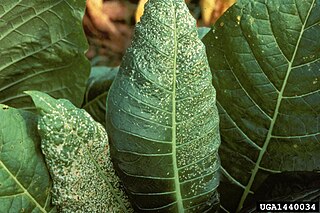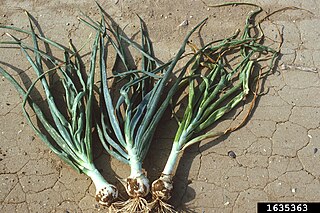Related Research Articles

Potyviridae is a family of positive-strand RNA viruses that encompasses more than 30% of known plant viruses, many of which are of great agricultural significance. The family has 12 genera and 235 species, three of which are unassigned to a genus.
Zucchini yellow mosaic virus (ZYMV) is an aphid-borne potyvirus, regarded as a major pathogen of cucurbits in most regions of the world where these crops are cultivated.

Potyvirus is a genus of positive-strand RNA viruses in the family Potyviridae. Plants serve as natural hosts. Like begomoviruses, members of this genus may cause significant losses in agricultural, pastoral, horticultural, and ornamental crops. More than 200 species of aphids spread potyviruses, and most are from the subfamily Aphidinae. The genus contains 190 species and potyviruses account for about thirty percent of all currently known plant viruses.

Papaya ringspot virus (PRSV) is a pathogenic plant virus in the genus Potyvirus and the virus family Potyviridae which primarily infects the papaya tree.
Asparagus virus 1 (AV-1) is one of the nine known viruses that infects asparagus plants. It is a member of the genus Potyvirus in the family Potyviridae. Initially reported by G. L Hein in 1960, it causes no distinct symptoms in asparagus plants. The only known natural plant host is the asparagus. It is spread by aphid vectors, which means that aphids do not cause the AV-1, but they do spread it.
Bean yellow mosaic virus is a plant pathogenic virus in the genus Potyvirus and the virus family Potyviridae. Like other members of the Potyvirus genus, it is a monopartite strand of positive-sense, single-stranded RNA surrounded by a capsid made for a single viral encoded protein. The virus is a filamentous particle that measures about 750 nm in length. This virus is transmitted by species of aphids and by mechanical inoculation.
Potato virus Y (PVY) is a plant pathogenic virus of the family Potyviridae, and one of the most important plant viruses affecting potato production.

Tobacco etch virus (TEV) is a plant virus in the genus Potyvirus and family Potyviridae. Like other members of the genus Potyvirus, TEV has a monopartite positive-sense, single-stranded RNA genome surrounded by a capsid made from a single viral encoded protein. The virus is a filamentous particle that measures about 730 nm in length. It is transmissible in a non-persistent manner by more than 10 species of aphids including Myzus persicae. It also is easily transmitted by mechanical means but is not known to be transmitted by seeds.
Tradescantia mosaic virus (TZV) is a plant pathogenic virus in the genus Potyvirus and the virus family Potyviridae. Like other members of the Potyvirus genus, TZV is a monopartite strand of positive-sense, single-stranded RNA surrounded by a capsid made for a single viral encoded protein. The virus is a filamentous particle that measures about 754 nanometers in length. This virus is transmitted by two species of aphids, Myzus persicae and Rhapalosiphum padi and by mechanical inoculation.

Turnip mosaic virus (TuMV) is a Potyvirus of the family Potyviridae that causes diseases in cruciferous plants, among others. The virus is usually spread by 40-50 species of aphids in a non-persistent manner. Infected plants, especially the natural hosts, show symptoms such as chlorotic local lesions, mosaic, mottling, puckering or rugosity. TuMV is a positive-sense single stranded RNA virus, consisting of a non-enveloped, helical capsid that is filamentous and flexuous, with an average length of 720 nm. The TuMV genome is linear and monopartite (single particle). The virus has a thermal inactivation point (TIP) of 62 °C, and longevity in vitro (LIV) of 3–4 days.
Commelina mosaic virus (CoMV) is a plant pathogenic virus in the genus Potyvirus and the virus family Potyviridae. Like other members of the Potyvirus genus, CoMV is a monopartite strand of positive-sense, single-stranded RNA surrounded by a capsid made for a single viral encoded protein. The virus is a filamentous particle that measures about 707-808 nm in length. This virus is transmitted by two species of aphids, Myzus persicae and Aphis gossypii, and by mechanical inoculation.

Watermelon mosaic virus (WMV) also known as Marrow mosaic virus, Melon mosaic virus, and until recently Watermelon mosaic virus type 2 (WMV-2), is a plant pathogenic virus that causes viral infection in many different plants. The virus itself is referred to as Watermelon Mosaic Virus II or WMV-2 and is an isolate of the U.S. WMV-2 is a ssRNA positive strand virus that is part of the Potyviridae or Potyvirus clade. Like all RNA viruses, it contains a protein capsid which protects the inner viral RNA. First described on squash in Florida, WMV arose from a unique recombination of genetic material contributed by Soybean mosaic virus (SMV) and Bean common mosaic virus (BCMV) along with Peanut Stripe virus (PSV).

Aphis nerii is an aphid of the family Aphididae. Its common names include oleander aphid, milkweed aphid, sweet pepper aphid, and nerium aphid.
Narcissus late season yellows virus (NLSYV) is a plant pathogenic Potyvirus of the family Potyviridae which infects plants of the genus Narcissus. It was originally isolated from N. pseudonarcissus in 1977.
Narcissus yellow stripe potyvirus (NYSV) is a plant pathogenic Potyvirus of the family Potyviridae which infects plants of the genus Narcissus. It is one of the commoner viruses infecting Narcissus, and is transmitted by aphids.
Greenidea formosana, also known as Greenidea (Trichosiphum) formosana, is an aphid in the superfamily Aphidoidea in the order Hemiptera. It is a true bug and sucks sap from plants.
Carrot virus Y (CarVY) is a (+)ss-RNA virus that affects crops of the carrot family (Apiaceae), such as carrots, anise, chervil, coriander, cumin, dill and parsnip. Carrots are the only known crop to be infected in the field. Infection by the virus leads to deformed roots and discolored or mottled leaves. The virus is spread through insect vectors, and is currently only found in Australia.

Onion yellow dwarf virus (OYDV) is a plant virus in the genus Potyvirus that has been identified worldwide and mainly infects species of Allium such as onion, garlic, and leek. The virus causes mild to severe leaf malformation, and bulb reduction up to sixty percent has been observed in garlic.
Garlic common latent virus (GarCLV) is a plant virus member of the genus Carlavirus that has been found infecting garlic globally. Detection of the virus in leek and onion has also been reported.
Shallot latent virus (SLV), a species of Carlavirus, was first identified in shallots in Netherlands. The virus particle is elongated, 650 nm in length.